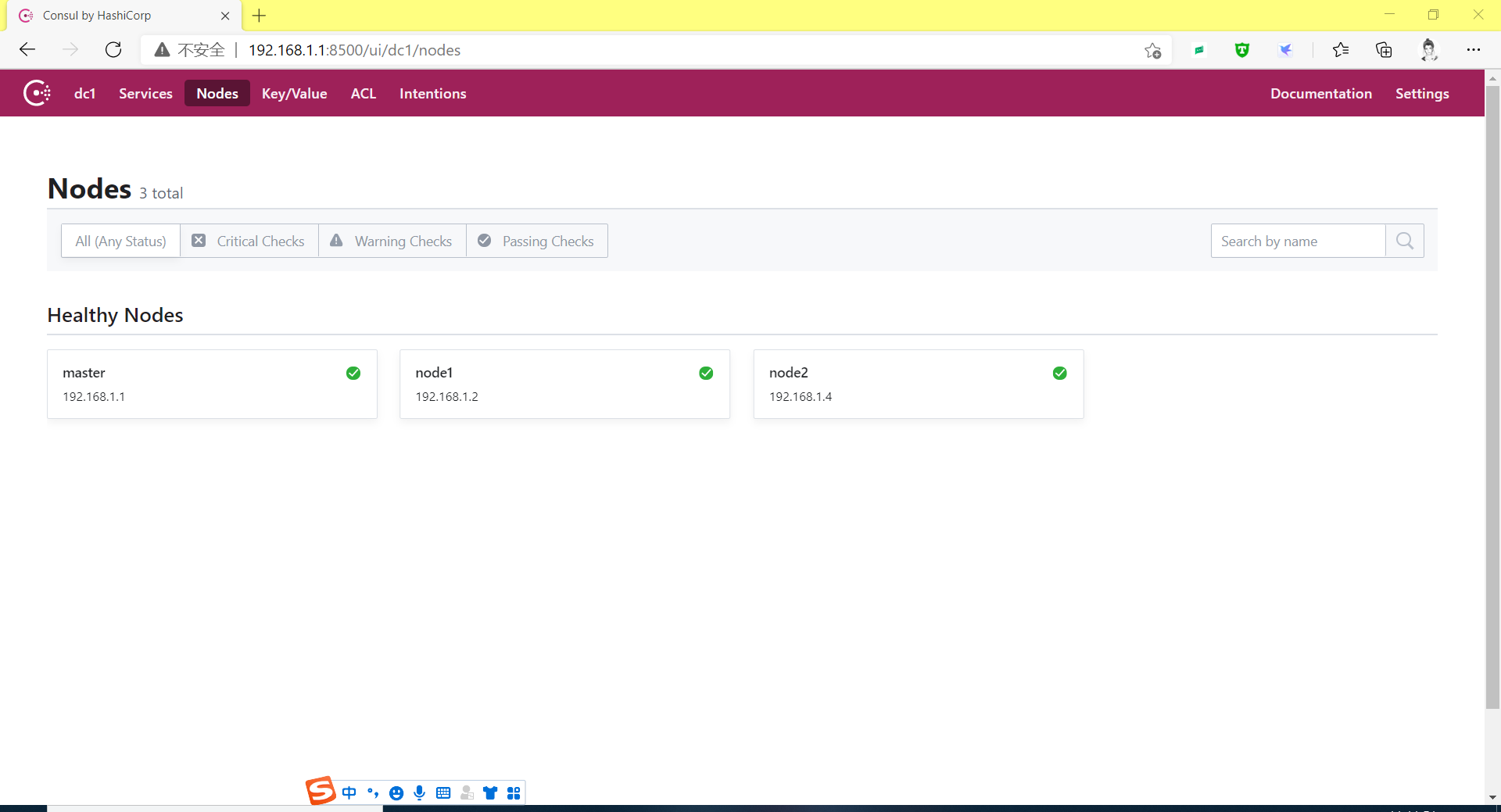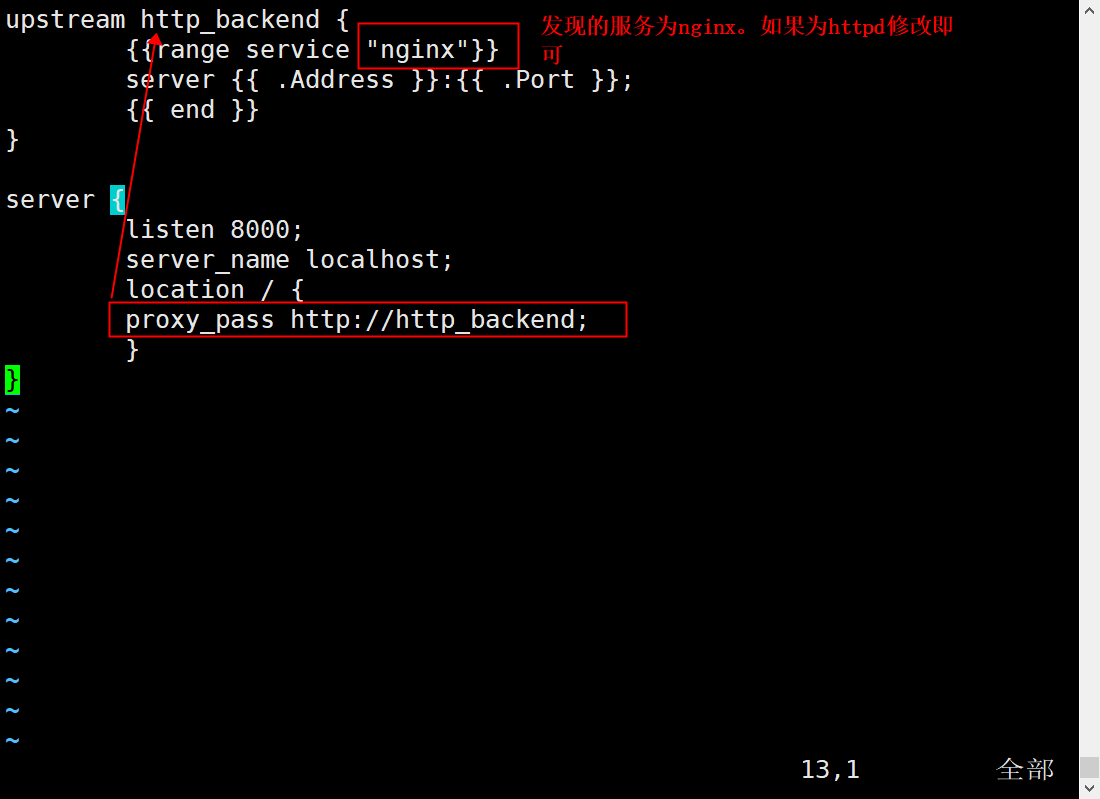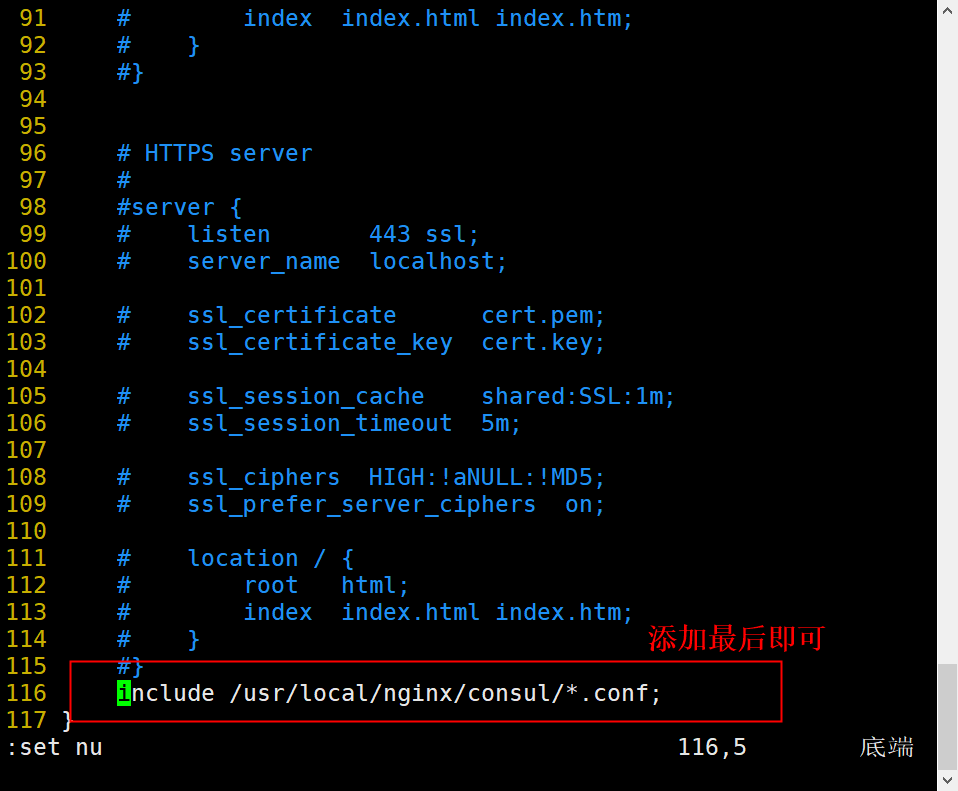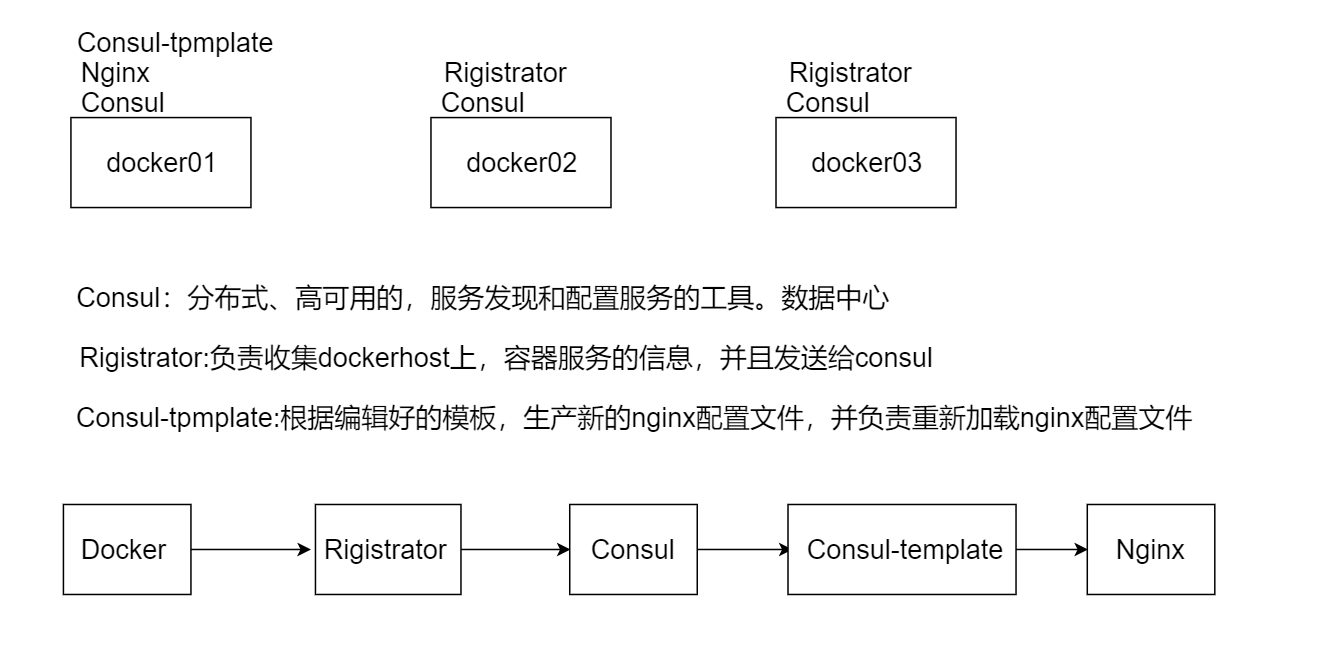| master | node1 | node2 |
|---|---|---|
| 192.168.1.1 | 192.168.1.2 |
#获取tar包 [root@master ~]# wget https://releases.hashicorp.com/consul/1.8.4/consul_1.8.4_linux_amd64.zip #解包 [root@master ~]# unzip consul_1.5.1_linux_amd64.zip Archive: consul_1.5.1_linux_amd64.zip inflating: consul #移动到/usr/local/bin目录是给用户放置自己的可执行程序的地方,推荐放在这里,不会被系统升级而覆盖同名文件。 [root@master ~]# mv consul /usr/local/bin/ [root@master ~]# chmod +x /usr/local/bin/consul #启动conusl服务,在后台运行 [root@master ~]# nohup consul agent -server -bootstrap -ui -data-dir=/var/lib/consul-data -bind=192.168.1.1 -client=0.0.0.0 -node=master &
命令解释:
nohup:要运行后台中的 nohup 命令
-bootstrap:一般运行在master节点,自动选举为leader(领袖)
-ui:开启consul内部的web界面
-data-dir:数据存储的位置
-bind:制定服务的server IP
-client:制定访问的客户端
-node:节点的名称,主机名
开启的端口:
8300 集群的节点
8301 集群内部的访问
8302 夸数据中心的通信
8500 web ui 界面
8600 使用dns协议查看节点信息的端口

1 //查看conusl信息 2 [root@master ~]# consul info 3 agent: 4 check_monitors = 0 5 check_ttls = 0 6 checks = 0 7 services = 0 8 build: 9 prerelease = 10 revision = 40cec984 11 version = 1.5.1 12 consul: 13 acl = disabled 14 bootstrap = true 15 known_datacenters = 1 16 leader = true 17 leader_addr = 192.168.1.1:8300 #consul节点IP:端口 18 server = true 19 raft: 20 applied_index = 60 21 commit_index = 60 22 fsm_pending = 0 23 last_contact = 0 24 last_log_index = 60 25 last_log_term = 2 26 last_snapshot_index = 0 27 last_snapshot_term = 0 28 latest_configuration = [{Suffrage:Voter ID:e2448f78-f220-e848-4316-128872e93ea1 Address:192.168.1.1:8300}] 29 latest_configuration_index = 1 30 num_peers = 0 31 protocol_version = 3 32 protocol_version_max = 3 33 protocol_version_min = 0 34 snapshot_version_max = 1 35 snapshot_version_min = 0 36 state = Leader 37 term = 2 38 runtime: 39 arch = amd64 40 cpu_count = 4 41 goroutines = 81 42 max_procs = 4 43 os = linux 44 version = go1.12.1 45 serf_lan: 46 coordinate_resets = 0 47 encrypted = false 48 event_queue = 1 49 event_time = 2 50 failed = 0 51 health_score = 0 52 intent_queue = 0 53 left = 0 54 member_time = 1 55 members = 1 56 query_queue = 0 57 query_time = 1 58 serf_wan: 59 coordinate_resets = 0 60 encrypted = false 61 event_queue = 0 62 event_time = 1 63 failed = 0 64 health_score = 0 65 intent_queue = 0 66 left = 0 67 member_time = 1 68 members = 1 69 query_queue = 0 70 query_time = 1

1 [root@master ~]# consul members 2 Node Address Status Type Build Protocol DC Segment 3 master 192.168.1.1:8301 alive server 1.5.1 2 dc1 <all>
将node1、node2加入到conusl集群
这里我们采用容器的方式去运行consul服务。
#这里名称一定要注意这是个坑,为啥写2,其实着有含义的1代表单机、2代表群集
#节点node1 [root@node1 ~]# docker run -d --name consu2 -p 8301:8301 -p 8301:8301/udp -p 8500:8500 -p 8600:8600 -p 8600:8600/udp --restart always progrium/consul:latest -join 192.168.1.1 -advertise 192.168.1.2 -client 0.0.0.0 --node=node1 #节点node2 [root@node2 ~]# docker run -d --name consu2 -p 8301:8301 -p 8301:8301/udp -p 8500:8500 -p 8600:8600 -p 8600:8600/udp --restart always progrium/consul:latest -join 192.168.1.1 -advertise 192.168.1.4 -client 0.0.0.0 --node=node2
#可能会遇到的问题,ipv4流量转发未开启,开启即可!
[root@node1 ~]# docker run -d --name consul2 -p 8301:8301 -p 8301:8301/udp -p 8500:8500 -p 8600:8600 -p 8600:8600/udp --restart always progrium/consul:latest -join 192.168.1.1 -advertise 192.168.1.2 -client 0.0.0.0 --node=node1 WARNING: IPv4 forwarding is disabled. Networking will not work. bd6660df07110e0e524112f931a65d17a54eb29e73cbe47e017bf012e662e07e [root@node1 ~]# echo net.ipv4.ip_forward=1 > /etc/sysctl.conf [root@node1 ~]# systemctl restart network [root@node1 ~]# systemctl daemon-reload [root@node1 ~]# systemctl restart docker [root@node1 ~]# docker restart consul2 consul2
访问地址:IP:8500

docker02、docker03上部署registrator服务
registrator是一个能自动发现docker container提供的服务,并在后端 服务注册中心注册服务或取消服务的工具,后端注册中心支持conusl、 etcd、skydns2、zookeeper等。
#在node1节点执行 docker run -d --name registrator -v /var/run/docker.sock:/tmp/docker.sock --restart always gliderlabs/registrator consul://192.168.1.2:8500 #在node2节点执行 docker run -d --name registrator -v /var/run/docker.sock:/tmp/docker.sock --restart always gliderlabs/registrator consul://192.168.1.4:8500 #注意IP地址为执行的宿主机IP
master部署一个nginx服务

//依赖环境 # yum -y install gcc openssl openssl-devel zlib zlib-devel pcre pcre-devel # useradd -M -s /sbin/nologin nginx # tar -zxf nginx-1.14.0.tar.gz # ./configure --user=nginx --group=nginx --with-http_stub_status_module --with-http_realip_module --with-pcre --with-http_ssl_module # make && make install # ln -s /usr/local/nginx/sbin/* /usr/local/bin/ # nginx -t nginx: the configuration file /usr/local/nginx/conf/nginx.conf syntax is ok nginx: configuration file /usr/local/nginx/conf/nginx.conf test is successful # nginx ------------------------------------------------------------------------ #PS: 这里nginx作为反向代理,代理后端docker02、docker03上nginx的 容器服务,所以我们先去docker02、docker03上部署一些服务,为了方便等会看到负载的效果,所以,我们运行完成容器之后,做一个主界面内容的区分。
nginx作为反向代理,代理后端node1、node2上nginx 的 容器服务,所以我们先去node1、node2上部署一些服务,为 了方便等会看到负载的效果,所以,我们运行完成容器之后,做一个主 界面内容的区分。
node1:web1、web2
node2:web3、web4

1 #创建nginx容器-p 随意映射容器内的80端口到宿主机 2 [root@node1 ~]# docker run -itd --name web1 -p 80 nginx:latest 3 77d39af9c5c8bcaa1839b9002bd09ac093f1e0699cef5bd04515ae38b1ceace8 4 [root@node1 ~]# docker run -itd --name web2 -p 80 nginx:latest 5 98ad0a4a5244cbb812ee1c5d2cee4818edc360d6eaea25c70c88f07e88d04a68 6 #修改容器的nginx首页 7 [root@node1 ~]# docker exec -it web1 sh 8 # echo web1 > /usr/share/nginx/html/index.html 9 # curl 127.0.0.1 10 web1 11 [root@node1 ~]# docker exec -it web2 sh 12 # echo web2 > /usr/share/nginx/html/index.html 13 # curl 127.0.0.1 14 web2

1 #创建容器 2 [root@node2 ~]# docker run -itd --name web3 -p 80 nginx:latest 3 29e0495b3a9c1db99f33374115d626fa37217ab67313e1e20845ccf2dd7ccb82 4 [root@node2 ~]# docker run -itd --name web4 -p 80 nginx:latest 5 2b2fcd9bd3742b9f806d1804a59a61c1f320bd616e66d5d216d6b2c85231fc20 6 #修改首页 7 [root@node2 ~]# docker exec -it web3 sh 8 # echo web3 > /usr/share/nginx/html/index.html 9 # curl 127.0.0.1 10 web3 11 # 12 [root@node2 ~]# docker exec -it web4 sh 13 # echo web4 > /usr/share/nginx/html/index.html 14 # curl 127.0.0.1 15 web4
更改nginx服务的配置文件

vim /usr/local/nginx/consul/nginx.ctmpl upstream http_backend { {{range service "nginx"}} server {{ .Address }}:{{ .Port }}; {{ end }} } server { listen 8000; server_name localhost; location / { proxy_pass http://http_backend; } }


1 [root@master ~]# vim /usr/local/nginx/conf/nginx.conf 2 116 include /usr/local/nginx/consul/*.conf; 3 [root@master ~]# nginx -t 4 nginx: the configuration file /usr/local/nginx/conf/nginx.conf syntax is ok 5 nginx: configuration file /usr/local/nginx/conf/nginx.conf test is successful

#重启 nginx -s reload
安装consul-template命令
Consul-Template简介
Consul-Template是基于Consul的自动替换配置文件的应用。在Consul-Template没出现之前,大家构建服务发现系统大多采用的是Zookeeper、Etcd+Confd这样类似的系统。
Consul官方推出了自己的模板系统Consul-Template后,动态的配置系统可以分化为Etcd+Confd和Consul+Consul-Template两大阵营。Consul-Template的定位和Confd差不多,Confd的后端可以是Etcd或者Consul。

[root@master soft]# unzip consul-template_0.19.5_linux_amd64.zip Archive: consul-template_0.19.5_linux_amd64.zip inflating: consul-template [root@master soft]# mv consul-template /usr/local/bin/ [root@master soft]# chmod +x /usr/local/bin/consul-template [root@master soft]# nohup consul-template -consul-addr 192.168.1.1:8500 -template "/usr/local/nginx/consul/nginx.ctmpl:/usr/local/nginx/consul/vhost.conf:/usr/local/bin/nginx -s reload" & [2] 5729 [root@master soft]# nohup: 忽略输入并把输出追加到"nohup.out" [root@master soft]# cat /usr/local/nginx/consul/vhost.conf upstream http_backend { server 192.168.1.2:32768; server 192.168.1.2:32769; server 192.168.1.4:32768; server 192.168.1.4:32769; } server { listen 8000; server_name localhost; location / { proxy_pass http://http_backend; } }
当然,这时不管后端是新添加nginx的web容器,或是删除,新生产的配置文件都会时时的更新,这时我们在运行consul-template这条命令最后添加: /usr/local/bin/nginx -s reload 它的作用。

1.浏览器访问consul ui ip:8500后报以下内容
Consul returned an error. You may have visited a URL that is loading an unknown resource, so you can try going back to the root or try re-submitting your ACL Token/SecretID by going back to ACLs. Try looking in our

#访问,实现了负载均衡 [root@master soft]# curl localhost:8000 web1 [root@master soft]# curl localhost:8000 web2 [root@master soft]# curl localhost:8000 web3 [root@master soft]# curl localhost:8000 web4 [root@master soft]# curl localhost:8000 web1 [root@master soft]# curl localhost:8000 web2 [root@master soft]# curl localhost:8000 web3 [root@master soft]# curl localhost:8000 web4 #停止node1主机的容器,查看实时发现效果 [root@node1 sfot]# docker stop web1 ^[[Aweb1 [root@node1 sfot]# docker stop web2 web2 #在master访问 [root@master soft]# curl localhost:8000 web3 [root@master soft]# curl localhost:8000 web4 [root@master soft]# curl localhost:8000 web3 [root@master soft]# curl localhost:8000 web4
文章来源: 博客园
- 还没有人评论,欢迎说说您的想法!



 客服
客服


